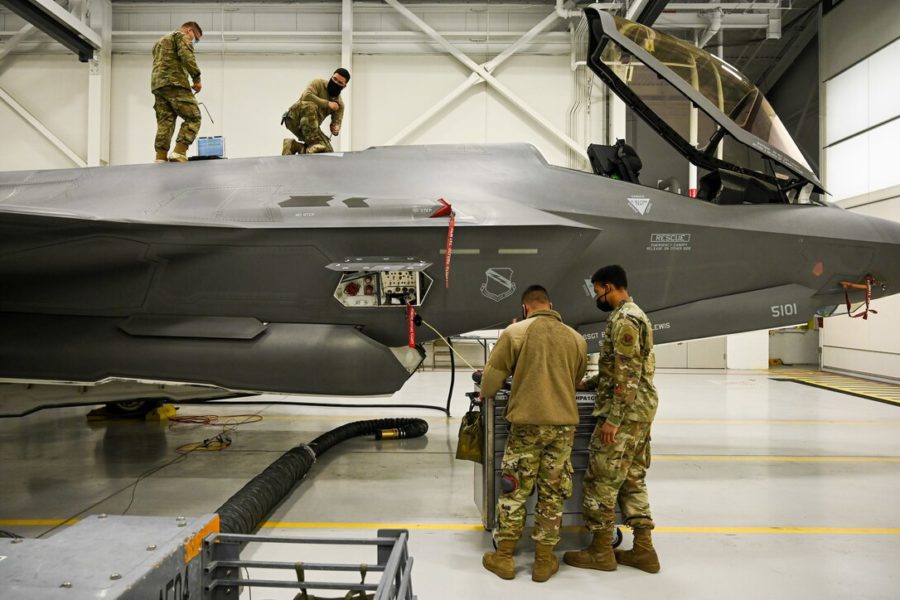The F-35 Joint Program Office will deliver a sustainment strategy for the Joint Strike Fighter this summer, with a sequenced plan that moves toward achieving—but probably doesn’t reach—a cost per flying hour of $25,000 by 2025, Program Executive Officer Lt. Gen. Eric T. Fick told Congress on April 22.
“We are … executing the business case assessment to determine what our long-term sustainment strategy needs to be for the enterprise,” Fick told the House Armed Services Committee. This strategy will be “released this summer” and it will determine whether the F-35 will be supported by a contractor Performance-Based Logistics deal, “more organic” support, or “something different,” he said
Lockheed Martin has reported that it expects a request for proposals on a Performance-Based Logistics contract this summer, and the JPO has whittled it down from its initial scope. Ken Merchant, Lockheed’s vice president of F-35 sustainment, in February called the likely deal a “skinny” PBL.
The JPO didn’t endorse the PBL concept as proposed because, “We didn’t want to get trapped into a mandate to sign a PBL contract that’s a bad deal before we’re ready,” Fick explained to the HASC panels. He said the JPO has been studying the PBL since Lockheed “dropped” the white paper proposing it “on Ellen Lord’s desk” 19 months ago. Ellen Lord was the Pentagon’s acquisition and sustainment czar in the Trump administration; her replacement has not yet been named.
He explained that “we simultaneously started to negotiate what we’re calling the fiscal years ’21-’23 annual sustainment contracts.” Until now, sustainment of the F-35 has been on an annual basis, which Lockheed has said is inefficient. It pitched the PBL so it and its vendors could make larger orders of parts and materials. The new deals, which Fick said will be three one-year agreements negotiated all at once, could pave the way for the PBL, which Lockheed has proposed as a five-year contract with five-year options.
The idea for a “supply-support and demand-reduction performance-based logistics contract … we decided was probably a good idea,” from the perspective of driving down the cost of parts, Fick said. The three-year negotiation will “inform how we move forward” with a PBL, he said.
The “entry point” for negotiations on the PBL will be the “handshake” on the FY ’21-’23 contract, which Fick said he’d hoped to have made by the hearing, but remains in negotiation.
“We’re using the ‘carrot,’ if you will, of the PBL, to make sure that we get a reasonable proposal to secure the tech data that the department needs to execute its intended strategy at the conclusion of the PBL and moving forward,” Fick said. Intellectual property and tech data rights remain a sticking point in discussions because ownership was not an issue early in the 20-year program. Now it is.
The three one-year sustainment deals have cost targets “intended to drive us toward $25K by ’25,” Fick said. “Will it get us there by itself? No. But the … cost per flight hour on ’21-’23 [will] move us down that path.”
The $25,000 figure is in 2012 dollars. The current-dollar cost per flying hour of the F-35A is $41,300. Lockheed is responsible for 39 percent of the sustainment cost; the rest is borne by engine maker Pratt & Whitney, the services, and some other vendors.
Lockheed aeronautics Executive Vice President Gregory M. Ulmer told the panel the company has reduced its share of the cost per flying hour by 40 percent so far, and will lower it another 40 percent over the next “three to four years.”
“Demand reduction” translates to higher-quality parts that break less often, but Air Force F-35 Integration Office Director Brig. Gen. David W. Abba told the committee the “break rate” of aircraft is only four percent per sortie. Newer aircraft are far more reliable and have much better mission capable rates than early-manufacture aircraft.
Fick also noted that the JPO is working with the services to determine if another layer of sustainment between the flight line and the depot is needed, noting the Navy having achieved success in accelerating parts repair using this “intermediate” support level. As a cost-saving measure, intermediate level maintenance was dropped early in the program.
Ulmer also reported that his understanding is that the Air Force only plans to retrofit aircraft from Lot 11 and beyond to the Block 4 configuration, which will require modifications and an update to the Tech Refresh 3 standard, which includes new processors, electronic warfare, and a large cockpit display.
